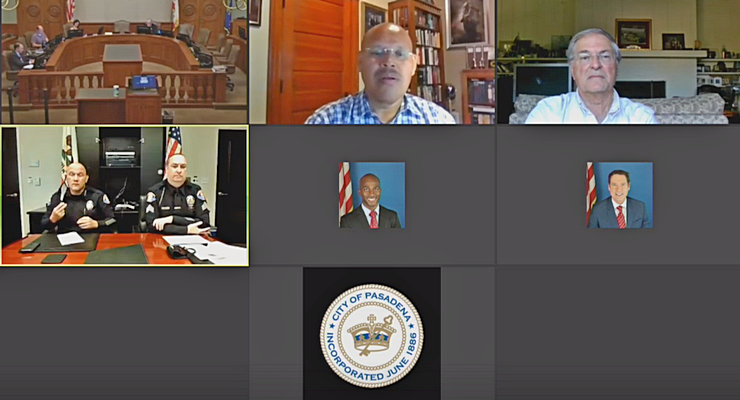
Amid calls from some quarters for the Pasadena police to end the use of facial-recognition technology, Chief John Perez went before the City Council’s Public Safety Committee this week to describe how his department uses the high-tech software in a limited way he called “essential’’ – but not for surveillance purposes that critics have said could be racially discriminatory.
“This is a very, very critical conversation for our community,’’ Perez said Wednesday during an information-only presentation to the Public Safety Committee.
“The digital upshot system, the facial-recognition conversation, is essential for us. It is my belief that it’s important to use this type of technology in our investigations not only for violent incidents, but [for] missing persons, child-abuse cases and so many applications. It’s important to have this discussion.’’
During a PowerPoint presentation, Perez and Sgt. Thomas Blanchard described how the PPD uses a software called LACRIS – short for L.A. County Regional Identification System – but only for what they said was a more efficient means of matching suspects’ faces with those already on file in the county’s mugshot database.
LACRIS is “only an investigation tool and not the basis for an arrest,” Blanchard said.
An arrest occurs only when a trained “face reviewer” – and Blanchard is one – eyeballs a digital image that’s been input into LACRIS and matches it, manually, to a mugshot already in the county’s database of arrestees, Blanchard said.
DNA, fingerprints and eyewitness IDs are among the subsequent means of establishing a suspect’s identity, the PPD officials said.
According to the PowerPoint presentation, the images that are input into the LACRIS system come from “still images captured from legally obtained surveillance footage, public resources or disseminated flyers from surrounding agencies.’’
“We used to use mug books … and it would take a detective several hours if not weeks to go through all the mugshot photos,’’ Blanchard said. “Basically, this system speeds it up for us and gets us possible matches … (from) the mugshot data system.’’
“The main thing is the human factor,’’ Blanchard stressed.
“How our investigative process works is, we’ll take a still photo from a video surveillance system … we’ll input it into the computer for the LACRIS system and then the possible matches, (and) it takes an examiner, one that’s gone through the training, (to) basically examine that photo with possible matches.
“So, the human factor takes all the bias out of that problem.’’
Still, inaccuracies in facial-recognition technology itself have led to questions of bias in cases around the nation.
According to Councilmember John J. Kennedy, chairman of the Public Safety Committee, bias is a concern because, “We know empirically that nearly 40 percent of the false matches by the facial recognition tool being used by police agencies involved people of color.’’
“My limited research reveals that facial recognition softwares have a harder time establishing the accurate identity of women and darker-skinned people,’’ Kennedy told Pasadena Now this week. “Such could have unintended outcomes and possibly life-limiting or eliminating results.
“Therefore, there must be appropriate and serious checks and balances of the use of facial recognition systems. If the concerns cannot be eliminated or reduced to acceptable levels in PPD’s use, I see no other option forward but to pause the use of the technology in Pasadena until the inherent biases have been arrested.”
Blanchard – asked by Kennedy if the Pasadena Police Department’s policies regarding facial-recognition should ease community concerns regarding racial bias – replied, “The technology that we’re using through the LACRIS system, that is correct, there is no bias.”
For his part, Perez said, “It’s very, very important as well for people to understand that (of) a 100 percent investigation, it (facial recognition technology as used by the PPD) is less than 1 percent of any investigation, and it is only a starting point for clues as to who a potential suspect might be.’’
“We take photographs and apply it to the current booking photos inside of the county booking system,’’ Perez said.
Perez said that LACRIS has been in use since 2009 and that, “We have used it about 800 times and we have had about 50 positive, helpful clues for us to start our investigations.’’
“There are a lot of public concerns when it comes to the use of this technology,’’ Perez also said. “We realize that, we understand it and we listen to those concerns when it comes to accountabilities, when it comes to management control, audits.’’
Significantly, Perez stressed that the PPD does not employ widespread camera surveillance and that by state law officers’ body cams cannot be equipped with facial-recognition or other “biometric surveillance systems,” according to the presentation.
The surveillance concerns were expressed by numerous public comments that were read aloud during Wednesday’s committee session. Representative of the comments were:
-
“It is entirely possible for Pasadena to outright ban facial recognition without passing a separate transparency and accountability ordinance. Any attempt to pass a surveillance oversight ordinance will legitimize surveillance and create pathways that police will use to introduce and win approval of new surveillance. We reject that. The community does not consent to surveillance. The ACLU trusts police to self-audit and self-govern, which has been proven repeatedly incapable to lead the proper accountability of wrongdoing.’’
-
“Surveillance has been used to criminalize the northwest community, the most segregated, policed and rapidly gentrifying neighborhoods in the city. Any creation of a surveillance bureaucracy only furthers the legitimization and expansion of policing technology to be used to further this anti-black, anti-immigration, racist displacement. Please ban facial-recognition software.’’
-
“History shows that laws facilitating the use of police technology will be used to establish new oppression.’’
-
“The people of Pasadena will not sit by passively while you enact policies that actively harm us.’’
Mayor Terry Tornek, a member of the Public Safety Committee, said, “There seems to be a disconnect between the PowerPoint presentation … but most of the comments that we’ve just heard relate to surveillance application.’’
“The presentation was about what sounded (like) a pretty modest facial-recognition tool to really accelerate processing of images and comparing them to mug books, which on the face of it seems to me, at least, to be pretty benign,’’ Tornek said.
City Manager Steve Mermell, meanwhile, said, “You have my commitment – I am not aware of us using any technology other than what the chief and the sergeant outlined today” — nor of any plans to expand the PPD’s use of facial-recognition technology.
“I think what we’re dealing with to a large measure is a public perception of the use of technology that our department is not employing, but there seems to be either a concern that we will or a misunderstanding that we are,’’ Mermell said.
Perez agreed.
“When it comes to the amount of violence we have, the property crimes, missing people, it’s just important for people to know it (facial recognition) is valuable to us, (but) there is no part of this that includes social-media scraping of websites or anything else that’s out there,’’ he said.
“Much of the confusion is centered on the false use of surveillance. We are focused on just that first step, (the mugshots and matching). … I do support the community’s concern …
“It absolutely isn’t (being used for surveillance).’’
André Coleman contributed to this report.














 0 comments
0 comments


